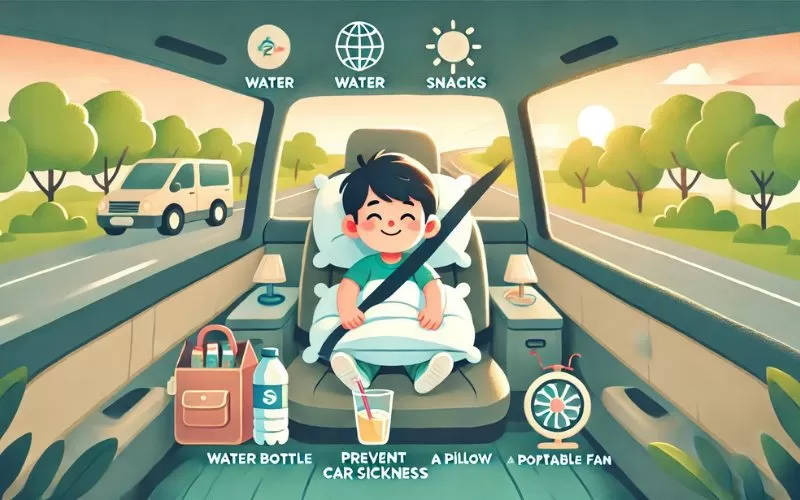Table of Contents
Prevent Children’s Car Sickness
Planning a road trip with children can be a fun adventure, but it can quickly become stressful if your little one experiences car sickness. Fortunately, there are simple and effective ways to prevent motion sickness and keep your child comfortable during long drives. In this guide, we’ll share seven practical tips for preventing children’s car sickness on road trips, helping you enjoy the journey without the worry of nausea or discomfort. Along the way, we’ll also recommend some essential products from our store to make your road trip smoother and more enjoyable.
For more information on how to alleviate car sickness in children, consider visiting Healthline’s guide on children’s car sickness. This resource provides comprehensive tips and insights, which can be incredibly helpful for parents looking to make car rides more comfortable for their kids.
1. Choose the Right Seat Position

Where your child sits in the car can significantly affect their susceptibility to motion sickness. The front seat or a middle seat in the back is often the best spot as it provides a clear view of the road, reducing the sensation of motion. Avoid placing your child in the back row or near the windows, where they may feel more motion and experience nausea.
Additionally, using a car seat with good support can make a world of difference. Car Seat offers extra cushioning and stability, keeping your child secure and reducing the chances of motion sickness during long drives.
2. Keep the Air Flowing
Fresh air is a natural remedy for car sickness, helping to reduce nausea by eliminating strong smells and keeping the air circulating. Open a window slightly to let fresh air in, or use the air conditioning to maintain a comfortable temperature in the car. If your child feels hot or stuffy, they’re more likely to feel sick.
Having a portable fan or air purifier, like our Clip-On Car Fan, can help improve air circulation in the back seat, ensuring your child stays cool and comfortable, especially during summer road trips.
3. Schedule Frequent Breaks
Long drives can exacerbate motion sickness, so it’s essential to plan frequent stops to give your child time to recover and stretch their legs. Stopping every two hours for a short walk or outdoor play can help reset their sense of balance and reduce nausea. During these breaks, encourage your child to drink water and get some fresh air.
Packing a travel-friendly blanket, such as our Cozy Travel Blanket, can also make these breaks more comfortable, allowing your child to rest or relax outside of the car.
4. Keep Snacks Light and Healthy

What your child eats before and during the trip can impact their likelihood of experiencing motion sickness. Avoid heavy, greasy, or spicy foods that could upset their stomach. Instead, opt for light, healthy snacks such as crackers, fruit, or yogurt. Also, keep your child hydrated with water or small sips of juice.
If you’re dealing with motion sickness and long drives with babies, it’s even more important to focus on simple and easy-to-digest foods.
5. Distract with Entertainment
Keeping your child’s mind off the motion can help prevent car sickness. Providing calming activities, such as audiobooks or music, can be an excellent way to distract them. It’s best to avoid screens, as focusing on a book or tablet can often make motion sickness worse.
Consider packing a few travel-friendly toys or puzzles that don’t require your child to look down for extended periods. Our Travel Fun Activity Pack is ideal for keeping kids entertained while minimizing the risk of car sickness. Plus, it can help reduce boredom during long drives, making the journey more enjoyable for everyone.
6. Try Natural Remedies
If your child is prone to car sickness, consider natural remedies to prevent and treat the symptoms. Ginger is known for its anti-nausea properties and can be given as ginger cookies, tea, or even ginger chews. Peppermint is another remedy that can help soothe nausea, whether through tea or peppermint oil on a handkerchief.
For car sickness in toddlers: remedies for motion sickness may also include wearing acupressure wristbands, which are designed to apply gentle pressure to the wrist to reduce nausea.
7. Know When to Use Medication
In some cases, natural remedies and preventive measures might not be enough, and medication may be necessary to prevent car sickness. Over-the-counter antihistamines like dimenhydrinate (Dramamine) or meclizine can help reduce symptoms of motion sickness. However, it’s always important to consult your child’s pediatrician before giving any medication, especially for young children.
If medication is recommended, ensure you give it to your child about 30 minutes before the trip for it to be effective. You should also pack any necessary medication in an easily accessible spot in the car.
Dealing with Motion Sickness and Long Drives with Babies
Long drives can be challenging when you have a baby on board, but by following these preventive tips, you can reduce the risk of motion sickness. From choosing the right seat position to providing light snacks, these strategies will help ensure your baby stays comfortable throughout the journey. Whether it’s through the use of natural remedies or the right accessories like Car Seat Cushion, keeping your baby content and nausea-free is easier with proper planning.
If your child is prone to car sickness in toddlers: remedies for motion sickness, always carry a backup plan, such as ginger chews, wristbands, and a few clean-up essentials. A little preparedness goes a long way toward ensuring a smooth ride.
How to Prevent and Treat Car Sickness in Kids

Knowing how to prevent and treat car sickness in kids is all about having the right tools and knowledge. From natural remedies to strategically planned breaks, preventing car sickness can save your trip from discomfort and unexpected stops. Equip yourself with the right products and techniques, and you’ll be well on your way to enjoying long drives with your children. Our store offers a range of products designed to make your travels easier, from the Cozy Travel Blanket to the Travel Fun Activity Pack.
Conclusion
Car sickness doesn’t have to spoil your road trip. With these seven tips, you’ll be better equipped to prevent and manage your child’s motion sickness. Whether it’s making sure they’re sitting in the right spot, ensuring proper air circulation, or using natural remedies like ginger and acupressure bands, every step can contribute to a more comfortable journey. With our specially curated products, such as the ComfortPlus Car Seat and Cozy Travel Blanket you can ensure that your next road trip is smooth and enjoyable for everyone involved.
Remember, dealing with motion sickness and long drives with babies requires a bit of patience and preparation, but by following these tips, you can minimize discomfort and ensure a fun and memorable trip for your family.

